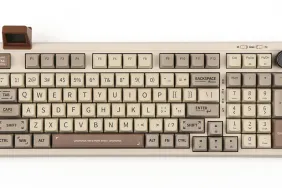The Prince of Persia returns… as a race car driver.
“Grid” spelled backwards is “dirg”. Substitute the seventh letter in the alphabet for the seventh-to-last letter in the alphabet, and you end up with “dirt”. Coincidence? I don’t think so.
[image1]Grid comes hot on the heels of Codemasters’ previous reworking of its other aging racing franchise. Dirt revisited and revamped the long-running Colin McRae Rally series with what was arguably the series’ best entry yet. And just like Dirt ditched its lengthy “Colin McRae Rally” moniker for the North American release, so too does Grid ditch its prior “TOCA Race Driver” moniker. Dirt updated a solid racing series, and Grid does the same. Neither game departs too far from its predecessors, but each adds just enough new features to improve on what came before.
Perhaps the most memorable feature of Dirt was its amazing menu presentation. Grid sets the bar even higher. If Grid were a restaurant, I’d never be able to order. I’d just keep flipping through the menu, laughing at all the people foolish enough to hand their menus over to their server.
In Grid, as you navigate your way through the menu screens, you’ll also navigate through your garage. The race selection menu is presented as a multi-tiered tool chest and trophy display. Your cars and their features are arranged as a stack of reference cards that you flip through as you choose which car to use. The menu system is easily the coolest feature of Grid just as it was for Dirt, and it’s silly how fun it is just to spend time navigating the menu screens.
Grid also uses many of the same assets as Dirt, so it looks, controls, and sounds an awful lot like Dirt. If someone were to pave all the roads in Dirt, you’d have Grid. And while it looks great, it’s not quite up to the graphical and audio standards set by the recent Gran Turismo 5 Prologue, but Grid is no slouch. The Milan course is particularly stunning. The other courses don’t stand out quite as much and can start blending together after a while, but everything runs so smoothly that you won’t care.
[image2]Besides, the real reason to play this game is for the damage modeling. If you were among the people standing at the gates with pitchfork in hand calling for the blood of Gran Turismo for not including ways to destroy high-end automobiles, you’ll find plenty to satisfy your metal-grinding lust in Grid. Fenders careen through the air, windshields crack, side panels deform, axles contort, metal slides across the tarmac. It’s a glorious thing to witness.
Even better, the game includes a robust replay mode that lets you revisit the ugliest crashes. There’s no way to save or share your replays, but it’s easy enough to get back out on the course and get yourself into another horrendous collision. It’s also not always easy to find the ideal angle for viewing the destruction in the replays, but you can usually find a camera position that gets the point across.
Grid continues in the same arcade-like direction that Dirt began traveling down. Once upon a time, the Race Driver series had been the closest competitor to the Gran Turismo series, but Grid leaves all of its sim-racing history behind in favor of a sleeker, faster, more energetic arcade racer. It’s not easy to take a turn poorly in Grid, since you can take turns at ridiculously fast speeds with little fear of losing traction. You can also safely brake through a turn at high speeds and not worry about spinning out. There are driving assists to further simplify the driving, but you probably won’t need them.
If you’ve played prior TOCA Race Driver games, the event types will all be very familiar, but now missing are the off-road events since those have all been moved over into Dirt. Replacing them are new additions that include drift racing and Japanese Touge racing, as well as the American-specific demolition derby. Even if the event variety is limited, there are enough race types to show off the versatility of the physics engine, and the demolition derby events show off how awesome the damage modeling is.
[image3]The most surprising addition to the series, however, is the implementation of the “flashback” feature. This works similarly to the rewind feature in Prince of Persia: Sands of Time. If you crash, take a turn too widely, or spin out, just hit the flashback button. Replay the past few seconds of the race until you get to a place you want to restart from, and try that tricky section over again. You have a limited number of flashbacks available, depending on the difficulty level. It’s a great idea, and frankly I’m amazed that no one’s thought of using it in a racing game before.
But it’s also an idea with its own inherent flaws. For one, if you’re a perfectionist, it easily makes you a sloppier driver. Knowing you have flashbacks at your disposal means that you’re less likely to be careful with your driving, so it becomes more like a crutch than a feature. Additionally, the flashback always defaults to a dynamic cinematic camera that isn’t helpful for seeing what you need to see, so you’ll always have to change camera perspective each time you want to use a flashback.
Grid improves upon much that Dirt established for Codemasters’ two racing series. But it also dumbs down racing more than Dirt did. In Dirt, there was still a strong expectation that you needed to hone your skills, and you still had the ability to tune your car—which was necessary in that game’s higher difficulties. In contrast, Grid just gives you fewer flashbacks in the more difficult modes with no tuning options whatsoever. To be sure, your opponents get faster, but not fast enough to force you to become technically proficient at racing; so long as you don’t make any stupid mistakes, you’ll do fine.
[image4]Racing in multiplayer forces you to be slightly more technical, but there’s little here that sets it apart from other racers. Multiplayer works very well and matchmaking happens very quickly, but obviously you can’t use the flashback feature during a multiplayer race. And without flashbacks, Grid is just another arcade-style racer with cool damage modeling.
Ultimately, Grid is a proficient and exceptionally well-presented racer. It has less course variety than most other racers of its kind, and while there are over 40 different vehicles, they aren’t all that different from one another. It’s great for pick-up-and-play sessions, and it’s ideal for those of you unwilling to spend time with a more technically demanding racer. Damage modeling is the best of its kind; busting up cars hasn’t been this fun since Burnout 3. Too bad it doesn’t also have that series’ sense of mayhem and whimsy.
Grid hits all the basics just right and tops everything off with a shiny, grease-covered bow. With a little more fine-tuning and some added variety, the follow-up could easily be the leader of the arcade racing pack.
-
Fantastic damage modeling
-
Easy to learn
-
Slick menus
-
Flashbacks are a lifesaver
-
. . .or an annoying crutch
-
Not very deep gameplay
-
Lack of course and vehicle variety











